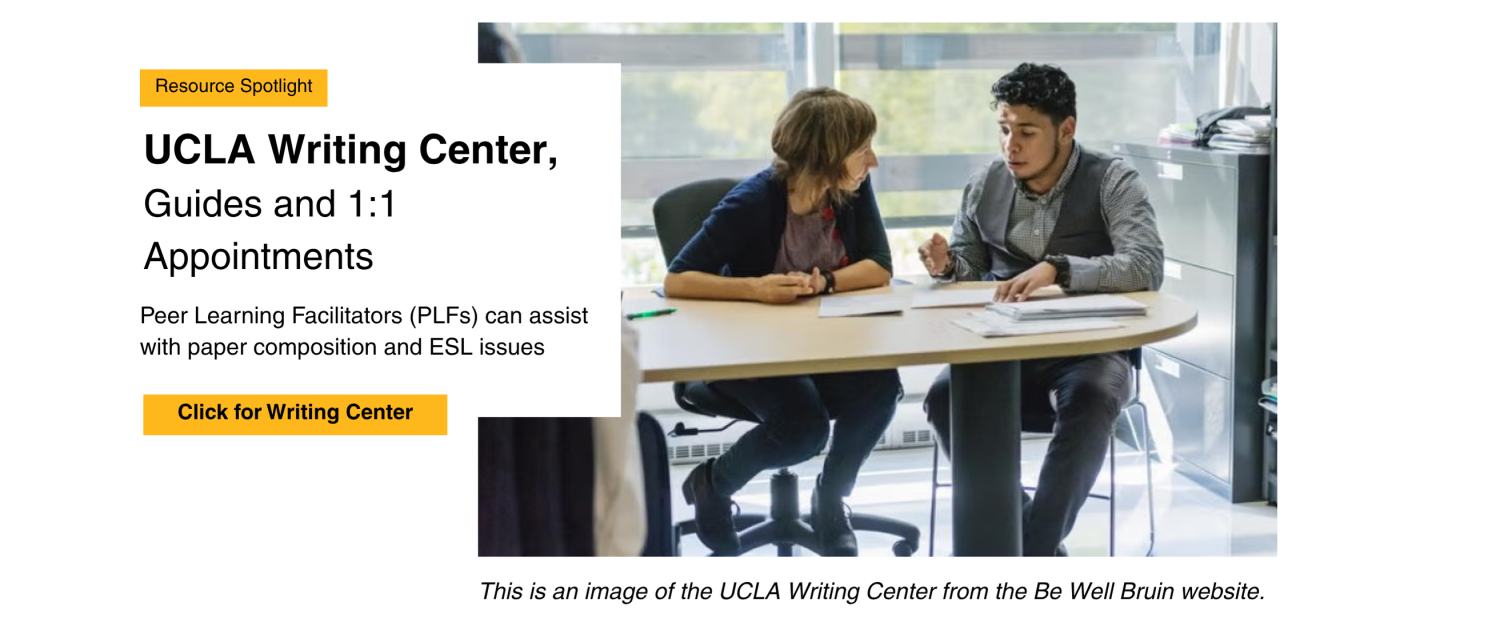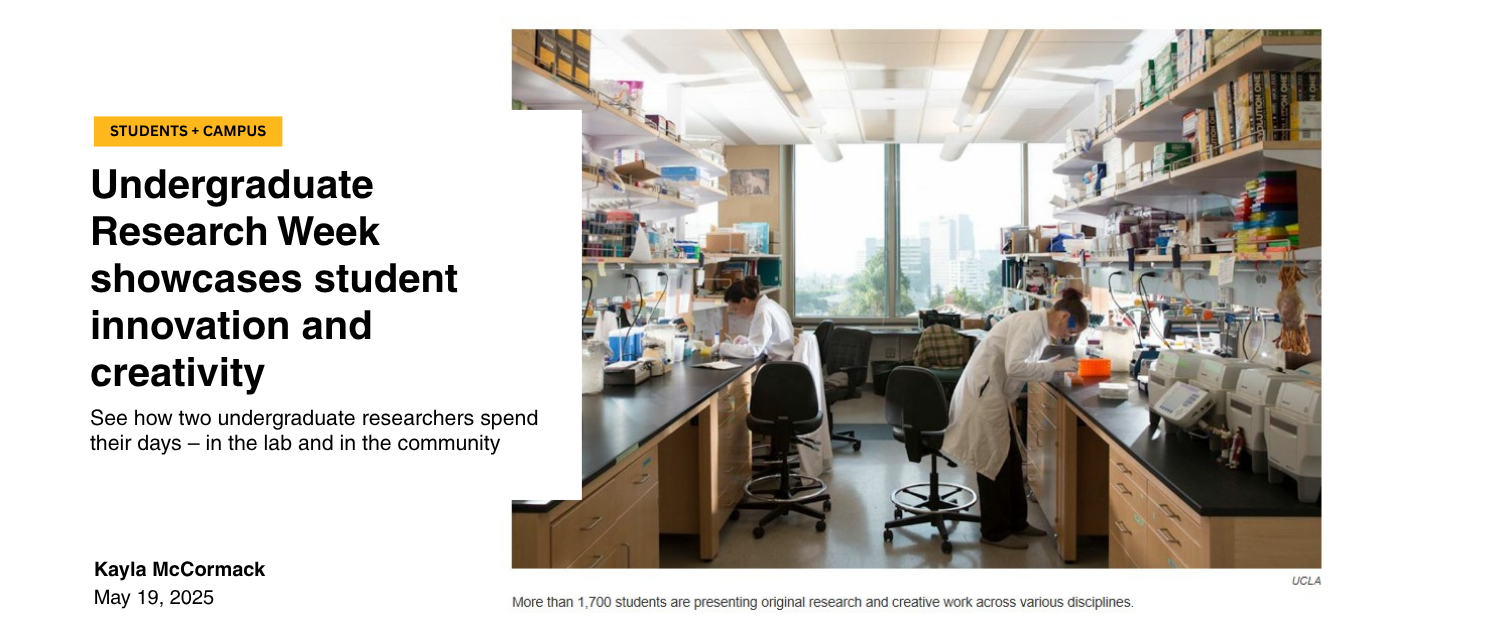NEED ACCOMODATIONS FOR RESEARCH?
Contact the Center for Accessible Education (CAE) if you need accommodations to participate in undergraduate research. Students are not required to be enrolled in a course as part of your undergraduate research experience for the CAE to assist you.
LEARN TO MAKE YOUR WORK MORE ACCESSIBLE
The UCLA Disabilities and Computing Program (DCP) offers trainings throughout the year on how to make digital content more accessible. These are great for students creating websites, presentations or documents.
ACCESSIBILITY TOOLS
- Check for Colorblind Accessibility: Use Vischeck to check charts, graphs, and figures for colorblind visibility.
- Add Alt Text to Images: Learn how to write alternative (alt) text so screen readers can describe your visuals to users with visual or cognitive disabilities.
- Make Your Documents Screen Reader-Friendly: Follow this PDF accessibility guide from UCLA DCP to format your documents for screen reader compatibility.
- Build Accessible Websites: Use this Web Accessibility Starter Guide to design websites that are usable by everyone, including people with disabilities.
What can you get out of attending a conference? Former student, Caliope Marin, shares her conference advice to students attending the Annual Biomedical Research Conference for Minority Students (ABRCMS) 2020 Conference, but it’s universal to any undergraduate conference.
CONFERENCES
Each year, hundreds of UCLA students present their research at numerous conferences across the country, which range from the regional and national level. There are also opportunities to attend a student-oriented conference.
There are also many opportunities for students to give poster or oral presentations on campus, including during Undergraduate Research Week.
LIST OF CONFERENCES
Below are a list of conferences UCLA students frequently attend and present at.
- American Association for the Advancement of Science Annual Meeting and Science Innovation Exposition
- American Chemical Society National Meeting
- American Geophysical Union Meeting
- American Indian Science and Engineering Society National Conference
- American Institute of Chemical Engineers Student Conference (AIChE)
- American Psychological Association Convention
- American Public Health Association Annual Meeting and Expo
- American Society for Biochemistry and Molecular Biology
- American Society for Cell Biology Meeting
- American Society for Human Genetics Annual Meeting
- American Statistical Association (ASA) Symposium on Data Science and Statistics
- Annual Biomedical Research Conference for Minority Students (ABRCMS)
- Association for Research in Vision and Ophthalmology (ARVO) Annual Meeting
- Biomedical Engineering Society Annual Meeting (BMES)
- Black Doctoral Network Conference (BDN)
- Citizen Science Association Biennial Conference
- Emerging Researchers National Conference (ERN)
- Great Minds in Stem Conference (GMiS)
- Gordon Research Conferences
- International Society for Stem Cell Research (ISSCR) Annual Meeting
- International Symposium on Visual Computing (ISVC)
- Latinxs & the Environment Conference
- Meteorological Society Student Conference
- Molecular Education and Research Consortium in Undergraduate Computational Chemistry
- National Collegiate Research Conference (NCRC)
- National Conference of Undergraduate Research (NCUR) – Submitting an abstract to NCUR? Information about the UCLA Campus Coordinator (PDF)
- Net Zero Conference
- Psychonomic Society Annual Meeting
- SACNAS Conference
- Sigma Xi Student Research Conference
- Society for Personality and Social Psychology Annual Convention
- Southern California Conference on Undergraduate Research (SCCUR)
- Stanford Research Conference (SRC)
- Undergraduate Research Conference in Chemistry and Biochemistry
- UCLA Psychology Undergraduate Research Conference
- US National Combustion Meeting
- West Coast Biological Sciences Undergraduate Research Conference (WCBSUR)
INSTAGRAM TAKEOVER
Check out our Instagram “Conferences” highlight to view a day in the life of one of our undergraduate researchers presenting at NCUR 2025.
JOIN OUR MAILING LIST
Join the URC-Sciences mailing list to be emailed monthly about upcoming conferences, program deadlines, and other resources.
Read Ten Simple Rules for Better Figures from PLOS Computational Biology
Use Vischeck to make sure your figures (charts, graphs, etc.) are visible to people with colorblindness.
Visit this page for information on how to add alternative text to images. Alternative text provides a textual alternative to images that can be read by screen readers, allowing it to be accessible to those with visual or cognitive disabilities.
Presenting your Research
Presenting your research is a culmination of the process of scientific discovery. Being able to clearly communicate your research to both general and scientific audiences is a key skill to develop.
RESOURCES FOR PRESENTING RESEARCH
Whether you’re designing a research poster or preparing an oral presentation, these tools and templates can help:
- Quick Guide: Creating Accessible Presentations
- 42″ by 42″ Poster Template (PowerPoint)
- How to Design a Scientific Poster
- Creating a Poster in PowerPoint
- Sample Poster Format (Jessica Jimenez, MARC)
- Poster Gallery for Inspiration
- Watch: Presenting STEM Research (URC Video) – (this resource is currently being created… stay tuned)
UNDERGRADUATE RESEARCH WEEK (URW)
UCLA’s Undergraduate Research Week is one of the largest university-hosted undergraduate research showcases in the country. Students from all disciplines present their work through virtual panels, recorded presentations, and creative performances.
Visit the Undergraduate Research Week website
EASEL RENTALS
UCLA departments and student organizations can borrow poster easels from the Undergraduate Research Center – Sciences at no cost. To check availability, email urcsciences@college.ucla.edu
POSTER PRINTING LOCATIONS NEAR UCLA
Looking for places to print your research poster? These UCLA-approved printing services can help:
- Bruin Custom Print
- CopyMat Westwood
- Department of Undergraduate Education – Technical Services
- Department of Psychology – Technical Services
- Life Sciences BioAdmin
- Mail, Document & Distribution Services (MDDS)
USING UCLA BRANDING AND LOGOS
UCLA Policy 110 states that individual UCLA students may use the Campus Logo, Campus Seal, or Unofficial Seal for student projects directly related to UCLA coursework– such as research posters or PowerPoint presentations- so long as they follow the UCLA Brand Guidelines and include their name and enrollment status.
Scientific Writing
Clear scientific writing is a crucial part of being a STEM researcher. Whether you’re writing a research abstract, preparing a journal submission, or applying for fellowships or graduate school, strong communication skills will set your work apart.
Explore resources below to support every stage of your writing process-from your first abstract submission to publishing your research.
WRITING SUPPORT AT UCLA
UCLA Writing Center
Get one-on-one feedback on abstract, personal statements, and STEM writing assignments. Peer Learning Facilitators (PLFs) can also support you with grammar, structure, and ESL challenges.
Explore Writing Center Resources
UCLA Library Research Resources
The UCLA Library offers research guides, research consultations, and subject area specialist support to help at every stage of the research process.
MAKE YOUR DOCUMENTS ACCESSIBLE
In scientific communication, clarity and inclusivity are essential for broad impact, ethical practice, and reaching the widest possible audience.
- UCLA Accessibility Guide for PDFs and Word Docs (Website)
- Use Vischeck to test charts/graphs for colorblind visibility (Website)
- Add alternative text to images (Website)
- Design accessible research websites (Website)
STEM RESEARCH CV/RESUME
CV Writing for Undergraduate Researchers
Use these resources to create a strong CV tailored to research positions, grad school, or industry.
- STEM CV Sample: New to Research (PDF)
- STEM CV Sample: Applying to Grad School or Jobs (PDF)
- Graduate Career Services: PhD Resume Book
- Watch: How to Write a Competitive STEM CV and Cover Letter (URC Video)
- Example Cover Letter
WRITING A RESEARCH ABSTRACT
A strong abstract is key when applying to conferences, journals, and scholarships.
- What is a Research Abstract (PDF)
- Step-by-Step Guide: How to Write an Abstract (PDF)
- Watch: Writing a STEM Abstract (URC Video)
WRITING A SCIENTIFIC RESEARCH PAPER
From your first research paper to a formal publication, these tools help you structure, revise, and improve your work.
- Scientific Writing Planning – Timeline Tool (Undergraduate Science Journal)
- Intro to Science Writing (Undergraduate Science Journal)
- Writing Strong Introductions & Conclusions (George Mason University)
- The Science of Scientific Writing (American Scientist)
- Scientific Writing Booklet by Marc Tischler, Ph.D. (PDF)
- WI+RE Tutorials for Reading and Analyzing Scientific Papers
- ORCCID ID – Track Your Publications
RESEARCH PROPOSAL WRITING
Develop competitive proposals for scholarships, fellowships, and research funding.
- Watch: Writing a Competitive Undergraduate Research Proposal (URC Video) – (this resource is currently being created… stay tuned)
- Explore Proposal Writing Resources at the UCLA Library
PUBLISHING YOUR RESEARCH AS AN UNDERGRADUATE
Publishing your research in a peer-reviewed journal is a great opportunity for any undergraduate. When you publish through Undergraduate Science Journal (USJ), you retain all rights to your article. Publication is also an excellent asset to graduate schools and research fellowship applications.
URC-SCIENCES TRAVEL
The URC-Sciences travel grant is currently closed.
HOW TO FIND UNDERGRADUATE TRAVEL GRANTS
Updated Fall 2025.
Use this guide to help you find funding support when presenting undergraduate research at conferences.
1. UCLA Resources
- Check if the URC-Sciences Travel Grant is open.
- Check your department and major for small research or travel awards. For example,
- Check applicable centers and student organizations. For example,
2. Explore Professional Organizations
- Many societies offer undergraduate travel awards. To find them search, “Undergraduate [your field] conference travel award.” For example:
3. Check Conference Websites
- Look under Awards, Funding or Student Resources.
- Here are some popular conferences that award travel grants.
4. Use External Databases
- Pathways to Sciences lists funding and travel opportunities.
- NSD REU listings sometimes include travel support.
5. Ask Your Research Mentor
- Faculty and departments often have access to travel funds or can recommend field-specific opportunities.



